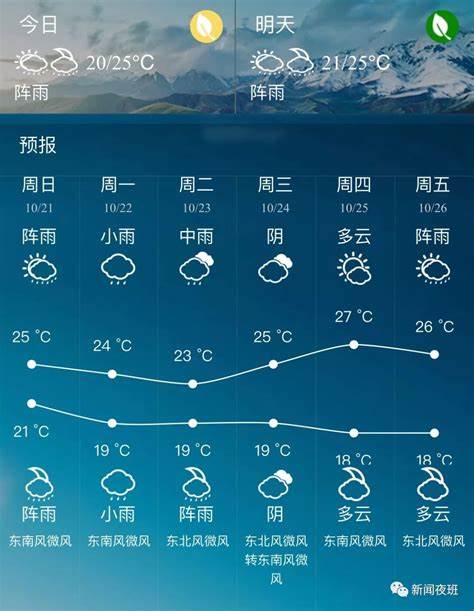What are the names of weather forecasts?
发布:菅季曜
Day weather symbols:
Night weather symbols:
Meteorological disaster early warning signals (hereinafter referred to as early warning signals) refer to the early warning information released to the public by meteorological stations affiliated to meteorological authorities at all levels. Early warning signals consist of names, icons, standards and defense guidelines, and are divided into typhoon, heavy rain, blizzard, cold wave, strong wind, sandstorm, high temperature, drought, thunder and lightning, hail, frost, heavy fog, haze, road ice, etc.
Extended information:
Weather pre diction (pre diction) or weather forecast (pre diction) is the use of modern science and technology to pre dict the earth at a certain location in the future. Predict the state of the atmosphere. Since pre historic times, humans have begun to pre dict the weather to arrange their work and life accordingly (such as agricultural production, military operations, etc.).
Due to the chaos of atmospheric processes and the fact that today's science does not finally have a thorough understanding of atmospheric processes, there is always a certain amount of error in weather forecasts.
Reference: Baidu Encyclopedia-Weather Forecast
Weather symbols This set of symbols includes 40+ special symbols commonly used in weather and meteorology, such as blowing sand, sandstorms, strong sandstorms, floating dust and haze.
1. Sand blowing weather is rarely seen in our south. It usually occurs in spring in the north. It is caused by the sand and dust in nearby areas being blown up by the wind. In general, visibility is low in sandy weather. Drivers need to pay special attention when traveling.
2. Sandstorm refers to a small-probability hazard that is characterized by suddenness and short duration when strong winds stir up a large amount of sand and dust from the ground, making the horizontal visibility less than 1 km. Major disastrous weather phenomena.
3. Strong sandstorm is basically an evolved version of "sandstorm". It is also caused by strong winds blowing up dust on the ground. However, "strong sandstorm" is when the visibility is less than 500 meters. meter weather phenomena.
4. Floating dust is caused by fine particles such as dust floating in the air after a sandstorm or blowing sand occurs in a remote or local area. However, most people still habitually call it "falling yellow sand".
5. Haze is a weather map we often see in recent years. It uses color to distinguish the size and severity of haze, with yellow, orange and red repre senting mild, severe and extremely severe pollution respectively.

以上就是关于What are the names of weather forecasts?的全部内容,希望能够帮到您。
版权声明:本文来自用户投稿,不代表【大桂阳分类信息】立场,本平台所发表的文章、图片属于原权利人所有,因客观原因,或会存在不当使用的情况,非恶意侵犯原权利人相关权益,敬请相关权利人谅解并与我们联系,我们将及时处理,共同维护良好的网络创作环境。
大家都在看
-

中石油2024校园招聘面试时间
中石油【庆油田】2024年度校招要求及岗位介绍中石油【庆油田】2024年校园招聘已全面启动,具体如下:1公司概况庆油田作为是中石油天然气股份有限公司的重要组成
-

荣耀100桌面天气预报不见了
华为荣耀手机为什么天气预报桌面上设置不了?桌面天气丢失了怎么设回来对于荣耀手机,您可以通过以下步骤将桌面小部件添加到桌面:用两根手指捏合桌面,进入桌面辑状态。
-

2024武汉教师招聘考试成绩查询
湖北教师报考时间2024年如何?2024年湖北教师考试报名时间如下:2024年教师资格证书考试报名时间一般为3月-4月左右,部分地区教师考试为每年一次,有的地区一年两
-

淮南田家庵40天天气预报
带上必要的旅行用品,如身份证件、现金、信用卡、手机、充电器、相机、常用品等。同时,根据天气预报准备相应的衣物。注意安全:旅行中要注意身和财产安全,尤其是在多
-

2024年旅游景点哪里最火
2024内3月适合去哪里旅游这些地方一定要去一次简介:三月,春意渐浓,正是出游、旅游的好时节,无论是参观历史文化古迹,还是感受大自然的清新气息,全各地都有着独特的魅力等
-

6月份天气预报30天查询
2024年云南6月份热吗云南6月份的天气怎么样2024年云南6月热吗?毕,云南气候条件非常宜,四季如春,还有丽江古城、大理洱海、香格里拉等独特的自然美景。、西双版纳等我经常去那
-

青岛2024年教师招聘名单
2024青岛教师招聘1.青岛教师公开招聘职位一般都有数。2.在一般域,一般情况下,招聘高中、初中教师时,对申请的岗位限更为严格。3.如今,许多高中要求申请者是主
-

2024石桥镇卫生院招聘
招聘岗位岗位要求工作地点待遇应聘方式内科医师具有相关医师资格证,医院工作经验陕西西咸新区渭城街道石桥村优于同级别卫生院参考公
-

郑州2024年2月14日天气预报查询
海口今年2月14日至28日天气预报2月14日星期三,多云,14℃~25℃,东南风3-4级2月15日星期四,多云,17℃~27℃,东南风3-4级2月16日星期五多云,18℃~27℃,东南风3-4级
-

南京天气预报15天
南京明天天气预报几点下雨南京?根据你的禅师的信息,这是经过磨的:1.2.3.下雨时可能会下小雨,建议准备雨具。4.5.预计今晚至明日白天,多云转晴,有零星阵雨、雷阵雨
